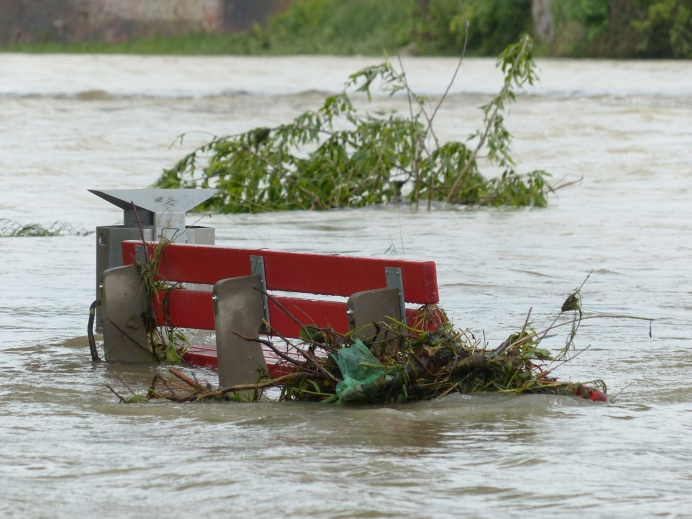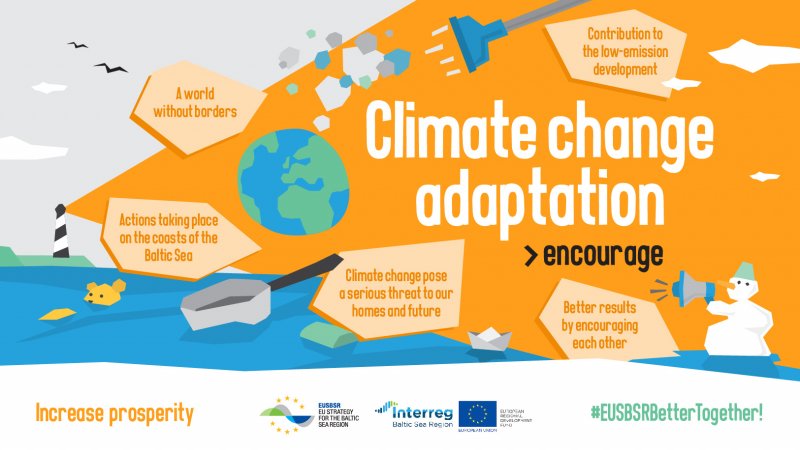What kind of risks does the climate change pose to the Baltic Sea region?
According to the conclusions of the BALTADAPT project, most climate change simulations reveal strong changes in the air temperature in BSR. The simulated increase is already statistically significant in the nearest few decades compared to the most recent past decades. The changes are largest in winter and most so in the north-eastern part of the domain, where a coupling to a reduction in snow and sea ice is evident. Temperature extremes are projected to change more than long-term averages. In winter, this implies that cold extremes in today’s climate will get very unusual in a future warmer climate, while summertime hot extremes are expected to be more intense than those today.
Simulated changes in precipitation in the Baltic Sea Region are large and indicate a wetter climate in the future. The projected increases are largest and most consistent during winter. In summer, the scenarios generally show more precipitation in the north and less in the south but there are large uncertainties in this, even concerning the sign of change. Also, precipitation extremes are projected to change with time and models show increasing amounts of precipitation associated with extreme events, also in areas that may experience decreases in seasonal mean precipitation. Climate change simulations reveal a large spread in changes in wind speed in the Baltic Sea region. Most projections show an increase of wind speed over the Baltic Sea in a future warmer climate but the uncertainty is large.
The projected regional climate change will have the largest effect on the rising sea level in the Bothnian Bay, the Gulf of Finland and the Gulf of Riga
The total rise will be much larger in the southern and south-eastern parts of the Baltic Sea while the northern part will be less affected. The consequences of rising sea levels will differ along the coastline where lowland areas and densely populated regions are more exposed. On a shorter time-scale the sea level in the Baltic Sea is affected by the local meteorological conditions which may cause an extreme sea level rise and flooding. The frequency of such events in the future climate is unpredictable.
The wave climate in the Baltic Sea is changing because of the largescale atmospheric circulation. Model simulations in the Baltic Sea show an increase in maximal wind speed and frequency of extreme events. Following these changes in wind conditions, the wave height and frequency of highest waves are also increasing. Therefore, the number of erosion events in the shallow areas is increasing as well.
All scenario simulations display increasing water temperatures, both for the volume average and for the sea surface. The largest change is obtained in the Bothnian Bay in summer. In winter, the largest increase is found in the Gulf of Finland. Changing water temperatures will have an impact on the occurrence and distribution of various species in the Baltic Sea. In summers, cyanobacterial blooms may be enhanced. In areas where late winter convection normally takes place an increased temperature may change the density distribution in such way that the deep convection is affected.
Substantial changes in the Baltic Sea ecosystem are expected
The sea will become more brackish, warmer and the sea level will rise in the southern part. Biological communities inhabiting the Baltic will change dramatically. Fewer species will be present in general and more freshwater species will penetrate the Baltic on expense of the marine species. Eutrophication may increase due to the expected increase in precipitation in the catchment area unless political action and proper management measures are taken. Increased plankton production and further reduction in oxygen concentration may cause even larger desert-like areas in the deeper parts of the Baltic, devoid of macroscopic benthic fauna and increase the areas where the species composition of today is changed. The increased plankton production and biomass in the surface layer will reduce light penetration and by that affect eelgrass meadows and seaweed forests on reefs and rocky shores.
In the Northern Baltic Sea, the expected lack of or reduced ice cover over the winter season will affect populations of birds and at least the ringed seal, and may have secondary impacts on numerous links in the ecosystem as cold-adapted species are replaced by freshwater species tolerating warmer water. Potentially large-scale functional changes in the ecosystem can be foreseen.
Infrastructure in the Baltic Sea region will be affected by climate change in various ways
Rising temperatures, decreasing sea ice cover, sea level rise, changing precipitation and storm patterns directly impact infrastructure such as coastal protection, maritime traffic, ports and tourism infrastructure. Indirect effects of climate change such as shifts in tourism or changes in demand, occurrence of new species and new diseases will have further consequences for the people’s health and for well-being. Also, economic sectors like forestry, agriculture, construction, energy production and transport will be affected by the climate change.
The Baltic Sea region is highly industrialized and populated, thus making it particularly vulnerable to climate changes. The riparian BSR countries share a certain responsibility to respond to the climate change and its possible impacts on human security, the environment and competitiveness in the region. It is therefore important to work not only on mitigation measures, but also on strategies to adapt to climatic changes. The establishment and implementation of the Macro-Regional Climate Change Adaptation Strategy and Action Plan in the BSR will strengthen efforts to such cooperation, based on the understanding of the specific impacts within the Baltic Sea Region.
On 28 November 2018 the European Commission adopted a strategic long-term vision for a prosperous, modern, competitive and climate neutral economy by 2050 – A Clean Planet for all. Both the Vision and the EU Strategy on Adaptation to Climate Change and the Council’s conclusions on this subject emphasize the importance and value added of knowledge and good practice exchange between member states, regions, cities and other stakeholders.
EUSBSR HA Climate aims to support the BSR transformation into a low carbon economy and strengthening societal capacity to adapt the climate change by:
- Facilitating integrative cross-sectorial policy discussions and alignment of policies in the Baltic Sea region countries;
- Promoting low- emission and climate resilient development;
- Promoting secure energy supply and efficiently using potential of renewable energy sources and promoting energy efficiency;
- Promoting sustainable production and consumption-oriented measures and
- Increasing coordination and synergy among initiatives and projects dealing with climate adaptation and mitigation in the Baltic Sea Region.
There are two main policy responses to climate change:
- Mitigation addresses the root causes, by reducing greenhouse gas emissions
- Adaptation seeks to lower the risks posed by the consequences of climatic changes
Both approaches will be necessary, because even if emissions are dramatically decreased in the next decade, adaptation will still be needed to deal with the global changes that have already been set in motion.
Adaptation means anticipating the adverse effects of climate change and taking appropriate action to prevent or minimize the damage they can cause or taking advantage of opportunities that may arise. It has been shown that well planned, early adaptation action saves money and lives later.
Examples of adaptation measures include:
- using scarce water resources more efficiently
- adapting building codes to future climate conditions and extreme weather events
- building flood defenses and raising the levels of dykes
- developing drought-tolerant crops
- choosing tree species and forestry practices less vulnerable to storms and fires and
- setting aside natutral land corridors to help species migrate etc.
Good example of cooperation between the BSR Countries on adapting to the climate change are EUSBSR Flagship projects
IWater and BSR Water platform bring together cities, regions, universities, NGOs and government agencies to exchange best practices and bring together knowledge and innovation potential of many countries on a transnational basis.
Based on experience of its partners, the BSR WATER develops an interactive online water management portal called Baltic Smart Water Hub to enable international knowledge and expertise exchange. An open access web portal promoting most recent good practices, technical solutions and tools developed in numerous water related projects covers four water sections: fresh-, sea-, storm and wastewater. The Hub allows wide dissemination of piloted practices and tools leading to the growing professional capacity of operators and further implementation of smart management of water resources in the Baltic Sea Region.
For more information about HA Climate of the EUSBSR, contact This email address is being protected from spambots. You need JavaScript enabled to view it.and dive into news and library section of the website http://haclimate.eu/.
Horizontal Action (HA) Climate is one of the four Horizontal Actions in the EU Strategy for the Baltic Sea Region. HA Climate represents Baltic Sea cooperation in the fields of climate adaptation as well as low emission development. The HA is led by the Sustainable and Prosperous Region Unit of the Permanent Secretariat of Council of the Baltic Sea States – CBSS.





